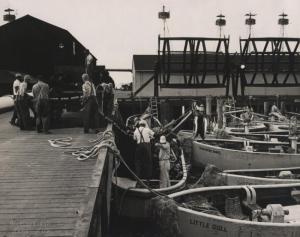New ordinance may allow menhaden net reel to stay

The menhaden fishing net reel is permitted to remain on the Lewes Historical Society campus while an ordinance is discussed to regulate placement of historical artifacts within the city’s cultural/historical zone.
Mayor and city council unanimously agreed at its Feb. 11 meeting to refer the issue to the historic preservation architectural review commission. Council determined this was the only option, as it does not have authority to overturn the commission’s previous decision that would force the historical society to remove the reel from its property.
“I may like it there and want it there, but it’s not the prescriptive route,” said Councilman Andrew Williams. “I don’t have the power as a councilperson to make the decision on whether it can stay there. We’re trying to find a path forward where maybe the process can be reset.”
The net reel was used to dry cotton fishing nets after boats returned to the menhaden fish factories that once lined the bayshore along Cape Henlopen Drive. The ongoing controversy began last fall, when the historical society moved the artifact from the banks of the Lewes-Rehoboth Canal, behind the life-saving station and next to the Lightship Overfalls, to the corner of Shipcarpenter and Third streets. The new location drew criticism from a group of residents in the nearby neighborhood who argued the reel did not fit in with the rhythm and scale of the streetscape.
Historical society officials also did not seek permission from the city to move the artifact. At historic preservation meetings last fall, society officials said they never needed approval to place artifacts on the campus in the past, and claimed a city official said it was OK.
When seeking retroactive approval for placement of the reel in September, the society’s application was denied by the historic preservation commission. Following the decision, city officials ordered the artifact to be disassembled and removed by Jan. 31, but the deadline was pushed back to March 5 due to ongoing discussions between the historical society and city officials. Now, with discussion of a new ordinance set to begin within the next few months, the reel is permitted to stay until the historic preservation commission completes its review. If a new ordinance is eventually approved by mayor and city council, the historical society may submit an application under the new rules.
City solicitor Glenn Mandalas said this is the most prudent path forward.
“The argument LHS has made is that the standards set out in city code right now for review of historical structures don’t adequately address things like historical artifacts,” he said. “Their argument has been that the standards were developed with a thinking toward new construction [or] renovation of historic properties without really giving thought to historic artifacts.”
Under the city’s charter, the historical society’s path after the initial denial would have been to resubmit an application to historic preservation. If denied again, it could appeal the decision to the city’s board of adjustment.
Deputy Mayor Bonnie Osler said historic preservation commissioners are the most qualified to discuss and possibly draft a new ordinance.
“No one on this council knows what a historic artifact definition would be,” she said.
Lewes Historical Society has indicated that it plans to include the fishing reel as part of a walking tour of Lewes that highlights the contributions of African Americans. In previous meetings, LHS Executive Director Jim Abbott said the artifact shares the story of 20th century Lewes when Blacks and whites worked collaboratively during the pre-civil rights era.
The issue struck a chord for Councilman Williams.
“It is an unfortunate situation we are in here,” he said. “I’m actually thankful for it because it has created a dialogue that is important, and it’s forced us to recognize what our history is and was. It reminds us of our heritage. I hope these two organizations can work together, because we’re all neighbors.”

















































